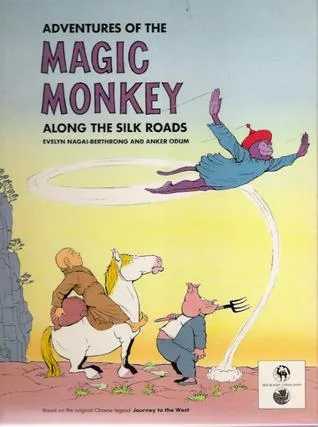Adventures of the Magic Monkey Along the Silk Roads (1983)
by Evelyn Nagai-Berthrong and Anker Odum
Royal Ontario Museum,ISBN 9780888543004
A friend used to loan me this lovely book when I was 12 or 13. I loved reading and re-reading it to the point where I remember asking him if he could just gift it to me for my birthday (he declined). And then Life happened and I grew up and I forgot all about it until around 3 years ago, when I suddenly went “wait a second” as I was casually reading some translation of Journey to the West. This book is a childrens’ adaptation of that classic Chinese tale! I then started looking for it, off-and-on, with very little luck.
Last year, LD told me about this absolutely lovely website called “Stump the Bookseller” run by LoganBerry Books in Cleveland. For a nominal fee, I submitted everything I could remember about the book hoping that someone would know it… only to find it myself that evening. My Google-fu had somehow improved after submitting that request. I bought it from AbeBooks posthaste.
This is one of my most precious of books.
It’s just a fantastic adventure to get lost in. To understand the Myth of the Monkey a little deeper, I turned to this paper by Professor Whalen Lai1. There’s just too much to quote but here’s a highly condensed TL;DR of both the book and the story:
Our search for the original face of Monkey should not distract us from his final destiny. Genealogy is only half the story. In his second westward trip Monkey rises above his animal past, above even humanity, to become a Buddha. In his first trip he acquired only Taoist immortality, and discovered only his premoral, childlike, monkey nature. Still capable of grudges against Heaven, Monkey loses his good temper and is damned for his Titanic pride. Only on his second trip West does Monkey, guided by the compassionate Guanyin, find his true self, his Buddha-nature. Guanyin teaches Monkey an invaluable lesson: that it is more important to tame the demon – the “monkey mind” – within than subdue the demons without.
In that second journey to the West, Monkey learns the art of Buddhist self-discipline. Guanyin initially puts a headband, a “crown of thorns” as it were, on Monkey’s forehead. The headband gives Monkey insufferable headaches every time he harbors evil thoughts. Mindfulness of good and evil eventually allows Monkey to “Do good, avoid evil, and cleanse the mind.” By journey’s end, Monkey is his own master, a victor over the demons within. When he finally asks Guanyin to kindly remove the headband, Monkey is told that it is not necessary. The crown of thorns had long since magically disappeared. At last this protean Ape had grown, in his progress as a pilgrim, into a Buddhist saint.
An Emeritus Professor of Religious Studies at UC Davis.↩︎
